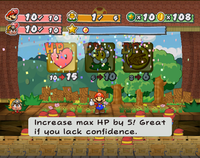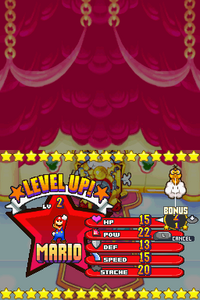Level up: Difference between revisions
No edit summary |
|||
| Line 39: | Line 39: | ||
The highest level in ''Mario & Luigi: Superstar Saga'' and ''Mario & Luigi: Bowser's Inside Story'' is Level 99, while the highest level in ''Mario & Luigi: Partners in Time'' and ''Mario & Luigi: Dream Team'' is Level 100. | The highest level in ''Mario & Luigi: Superstar Saga'' and ''Mario & Luigi: Bowser's Inside Story'' is Level 99, while the highest level in ''Mario & Luigi: Partners in Time'' and ''Mario & Luigi: Dream Team'' is Level 100. | ||
For some | For some reason, Stache will never go up on its own; the player must use the bonus to level it up. | ||
{{BoxTop}} | {{BoxTop}} | ||
{{Super Mario RPG}} | {{Super Mario RPG}} | ||
Revision as of 12:30, May 20, 2015
It has been requested that this article be rewritten and expanded to include more information.
- “Wahoo! One more suit, and it's 1-Up time! I mean, level-up time!”
- —Mario, Fortune Street
Level up is a term in role-playing games. Characters must defeat enough enemies in battle to gain enough experience points to level up. As characters grow to higher levels, more experience points are needed to level up. Once characters level up, their stats are increased, and in some games, they may also learn a new skill or attack.
History
Super Mario RPG: Legend of the Seven Stars
Upon leveling up in this game, Mario or one of his allies can chose one of three stat combinations to get a bonus on along with the regular stat boost. The three choices are attack and defense, represented by a hammer; max HP, represented by a Mushroom; and magic attack and magic defense, represented by a star. These bonuses are slightly boosted at certain levels: physical bonuses are higher on levels that are 3n (n being an integer), HP bonuses are higher on levels that are 3n + 1, and magic bonuses are higher on levels that are 3n - 1. At certain levels, the characters will learn a new special magic ability. The maximum level is 30.
Paper Mario series
Paper Mario and Paper Mario: The Thousand-Year Door
In both of these games, Mario levels up every 100 Star Points. Instead of the requirement for leveling up increasing with each level, the number of Star Points gained from enemies decreases.
At each level up, Mario must choose one of his stats to boost. If he chooses HP or FP, his maximum for that stat increase by five points. If he chooses BP, his maximum BP will increase by three points. The stats not chosen remain unchanged. Unlike most RPGs, leveling up will never directly increase Mario's attack power.
Leveling up also fully restores Mario's HP and FP and his active partner's HP in Paper Mario: The Thousand-Year Door. The maximum level Mario can reach is 27 in Paper Mario, and 99 in The Thousand-Year Door.
In Paper Mario, the music played when the player levels up is a remix from Super Mario Bros. 3's overworld theme from World 1.
Mario's partners can also be ranked up, similar to a level up, which increases their attack power and teaches them a new move, and increases their HP in Paper Mario: The Thousand-Year Door. In Paper Mario, this is done using a Super Block. These blocks are spread throughout the Mushroom Kingdom. Using one allows Mario to upgrade one of his party members to Super Rank. After he has received the Ultra Stone from Raphael the Raven, he can use Super Blocks to upgrade Super Rank partners to Ultra Rank. Each Super Block can be used only once.
In Paper Mario: The Thousand-Year Door, Merlon can level up Mario's partners, for three Shine Sprites each. One level up will upgrade a partner to Super Rank. To level up the partners again, Mario must first obtain the Up Arrow. After doing so, Merlon can level them up to the Ultra Rank.
Super Paper Mario
In this game, level up bonuses are preset, alternating between an increase of five HP at every even-numbered level and one attack point at every odd-numbered level. All party members in this game share the same stats, excluding Bowser, who shares HP but has double attack. As is the case with The Thousand-Year Door, the maximum level the party can reach is 99.
Like in previous Paper Mario games, the player's HP is fully restored with each level up.
Mario's party can also permanently increase their HP and attack power without leveling up by using the HP Plus and Power Plus items. However, both of these items are very rare.
Mario & Luigi series
In these games, max HP, max BP (Mario & Luigi: Superstar Saga and Mario & Luigi: Dream Team), max SP (Mario & Luigi: Bowser's Inside Story only), Power, Defense, Speed, and Stache (Horn for Bowser) are all initially increased immediately after leveling up, generally anywhere from zero to five points, but as high as fourteen in Partners in Time. The player can then choose any stat they want and give additional points to it.
A roulette determines how many additional points are added. The possibilities are 1 to 5 in Superstar Saga, 1 to 6 in Partners in Time, 1 to 9 in Bowser's Inside Story, and 1 to 5 in Dream Team. However, the roulette will often not include this entire range, since the numbers that appear on the roulette are reduced with each level-up a given stat is upgraded and increased with each level-up that it isn't upgraded.
The highest level in Mario & Luigi: Superstar Saga and Mario & Luigi: Bowser's Inside Story is Level 99, while the highest level in Mario & Luigi: Partners in Time and Mario & Luigi: Dream Team is Level 100.
For some reason, Stache will never go up on its own; the player must use the bonus to level it up. Template:BoxTop Template:Super Mario RPG

